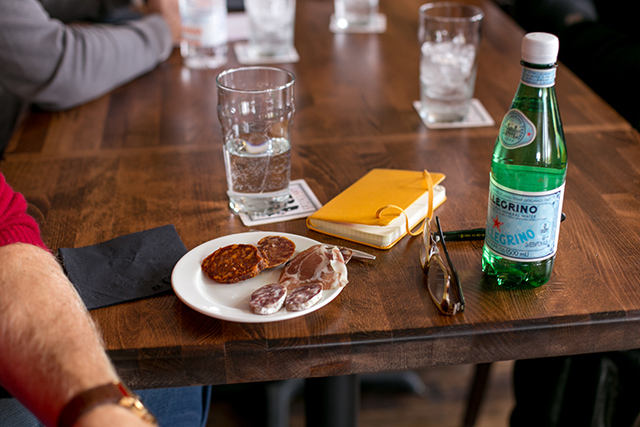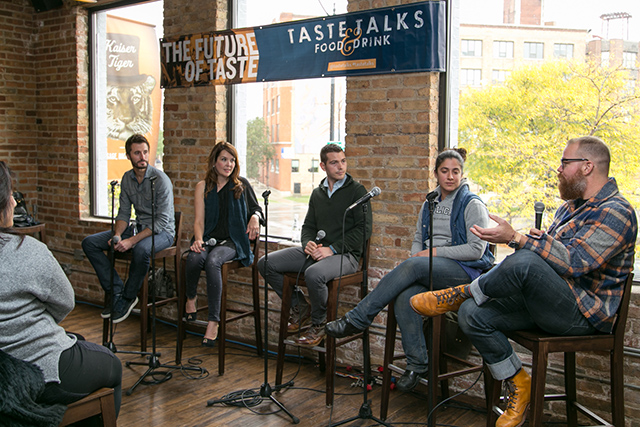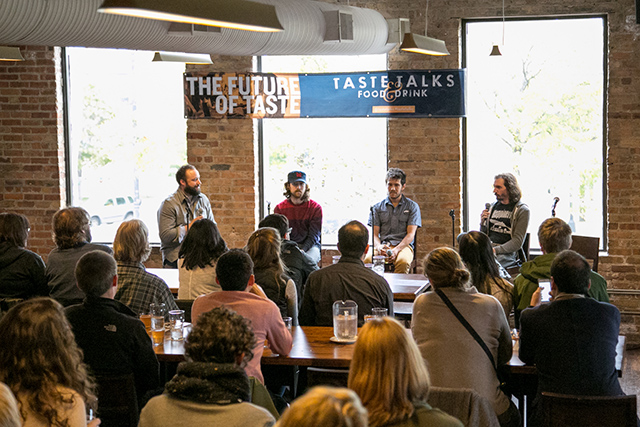A Day Of Learning, Drinking And Eating At Chicago's First Taste Talks
By Melissa McEwen in Food on Oct 9, 2014 8:30PM

Snacks at the charcuterie panel (Photo by Potluck Creative)
Last weekend the Chicagoist team grabbed our notebooks and headed to the first Chicago Taste Talks for some serious learning time. But it was more fun than college lectures since there was plenty of beer, cider, cocktails and delicious snacks. But like college lectures, we did have some homework, which was penciling down what some of our best local food and drink gurus had to say while struggling to hold our bounty of treats like cider doughnuts and bourbon.

(Photo by Potluck Creative)
The Art of Salted & Dried Charcuterie
The art of charcuterie is still a fairly new venture in Chicago, but butchers and chefs are already creating next-level cured meats. This panel consisted of Missy Corey of Publican Quality Meats, Chris Marchino from Spiaggia and Greg Laketek from West Loop Salumi. From the clean, classic Northern Italian style of salami from West Loop, to the more outlandish interpretations like a tongue taco-inspired headcheese found only at PQM, their expansive perspectives taught us a lot about the art of curing meats.
When it comes to casing, each animal’s intestine is distinct. Lamb and sheep casings are smaller and thinner, which work well for snack sticks or other small format salamis that require a shorter drying period, while beef and pork casings work better for large, mature salamis. As far as pairing goes, the key is to balance the fatty charcuterie with a little acid. Drink pairings such as acidic wines and beers or even cocktails with a bourbon or tequila base work well. You can always pair cured meats with a pickle or selection of fine cheeses.
So what’s the next big thing in charcuterie? The panel agreed that they were most excited about culatello, a style similar to prosciutto but much more complex and difficult to achieve. It begins with the large side of the pig’s leg, which is skinned, deboned, stuffed into a bladder and aged for up to 12 months. I hopped over to West Loop Salami (1111 W Randolph St.) to try it myself after the lecture and it was incredible- dryer than prosciutto di parma, but much more robust and with aromas of garlicky almonds. West Loop is currently serving it on a sandwich with exquisite parmigiano, but because of culatello’s finicky nature it is in extremely limited supply. If you’re interested in making your own charcuterie, it’s best to start with confits, rillettes or pâtés.- Erika Kubick

(Photo by Potluck Creative)
How We Eat Meat Now
The way consumers purchase meat has changed dramatically over the past 10 years, with once blinded, value-driven consumers now expressing a new interest in where their meat comes from and how it’s handled. This session focused on these changes as seen by those working in the meat industry. The panel of meat lovers included Connie De Sousa and David Flam of Charcut in Canada, Cosmo Goss of The Publican, and Michael Mason of David Burke’s Primehouse.
The panel had strong opinions on the topic of grassfed beef, all agreeing that it doesn’t necessarily mean higher quality. In fact, it can mean that the quality is worse because few breeds of cattle can convert the plant sugars in grass into fat in the way they do corn, resulting in weak marbling. The panel agreed that the animal’s overall lifestyle is what’s important, while commercial buzzwords are often misleading.
Dry-aging was another topic during the meat centered discussion. Connie De Sousa stated that like a fine cheese, a matured steak takes on the flavors of the area in which it is aged - a funky, acquired taste. If you haven’t had one before, it’s best to go with a milder, younger steak. Mike Mason related how David Burke’s once aged a steak for 365 days. The resulting steak was a little mushy, but popular with some consumers including one man who ordered two. Cosmo Goss detailed his successes with dry-aging poultry at The Publican, including guinea hen, duck breast and squab. Now that’s something I can get down with. - Erika Kubick
Small Distillers + Great Barkeeps
At Small Distillers + Great Barkeeps host Amy Cavanaugh brought Chicago Distilling Company co-owner Jay DiPrizio, Rhine Hall Distillery co-founder Jenny Solberg and Few Spirits brand rep Alison Mouratis together. Their companies all produce a diverse range of spirits that have really put Chicago on the map in terms of the nouveau distilling movement. But they have one big thing in common - struggles with red tape. Jay said distilling requires coordinating with complex regulations as the city, state, and federal level.
He found the city supportive but the dealing with the federal regulators was a “pain.” “You need to have the majority of your equipment already on premise for federal approval and then just sit and wait” Jay said. That requires a high level of risk- buying expensive equipment before you even know whether or not your business will make it through the regulatory hurdles.
But Jay said an upside is laws in Illinois requiring distillery tap rooms to only serve their own spirits on premise has forced them to get creative and produce a wider variety of spirits. That’s how Chicago Distilling Company got started making Finn’s Gin, which is now one of their flagship products.
They also all use local produce and grains to make their spirits. Jenny said “it really makes the most sense, depending on the produce price. We have so many resources in Southwest Michigan.” Jay said he has cultivated relationships with local grain farmers who also help source from other nearby farmers when they can’t meet the demand. “People are now discussing terroir in spirits” Jay said.
Attendees enjoyed cocktails made with their spirits, including an outstanding creamy and buttery horchata cocktail made with Few bourbon that Mouratis infused with peanuts. - Melissa McEwen

(Photo by Potluck Creative)
The Wildest Brews In Town
With a name like “The Wildest Brews In Town”, one might imagine Taste Talks Chicago’s event at Kaiser Tiger would be discussing beers made with papaya, banana peppers, or horse radish.
That wasn’t the case.
Hosted by Michael Kiser (founder of Good Beer Hunting), and featuring Tim Faith of Goose Island, John Laffler of Off Color and Eric Olson of Marz Brewing, the panel focused more on the ambitious nature of the American craft brewer. American brewers are constantly experimenting and pushing the boundaries, unlike most of their European counterparts. This is what makes us so wild!
This experimentation may come through playing with hop genetics, as Faith explained, or trying different strains of lactobacillus, like Olson did with Marz’s Berliner Weisse “Community Bubbly Creek”.
Audience members were given samples of each panelist’s beer, all done in a Berliner Weisse style, receiving “Lilith” from Goose Island, “Fierce” from Off Color, and “Community Bubbly Creek” from Marz Brewing. - Ben Kramer
In Cider Spirit
For In Cider Spirit, Kate Bernot gathered some of the Midwest cider community’s sages including Greg Hall of Virtue Cider, Richard Bertsch of Prima Cider, Brian Rutzen, the beverage director of forthcoming cider bar The Northman and Charlie Davis and Katie Morgan from the upcoming cidery Right Bee to talk about the the rising popularity of cider.
Many of the panelists first fell in love with cider abroad. When Greg Hall worked in beer as Goose Island’s brewmaster he toured England with other brewers and stopped at pub in York called The Maltings which happened to have 40 ciders on tap. They decided to try a few and “holy cow they were great” Greg says. They ended up trying them all. Katie also fell in love with cider in England and when she met Charlie, a professional brewmaster, in 2011, they decided to make cider together.
But Greg dismissed recent articles that claim that the best cider is made with European apples. Richard said we need to recognize American cider as its own thing, which needs time to find its own particular styles. “We have not yet discovered the best American cider varieties… our climate is different from Europe’s, the European varieties won’t taste the same here” he said.
Brian reminded the audience that America has a rich history of cider making, but Prohibition put a damper on our progress in terms of developing our own cider culture. But thankfully cider’s newfound popularity means it can now continue helmed by passionate cider makers and a culture of drinkers that Hall says “have more expansive palettes, now everyone drinks everything.” - Melissa McEwen